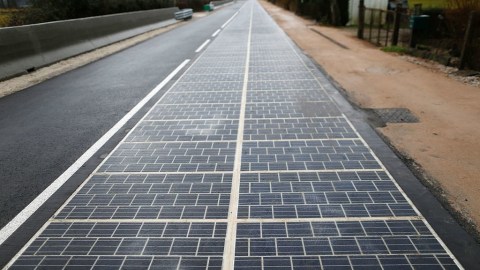First solar roadway in France turned out to be a ‘total disaster’

Image source: Charly Triballeau / AFP / Getty Images
- The French government initially invested in a rural solar roadway in 2016.
- French newspapers report that the trial hasn’t lived up to expectations.
- Solar panel “paved” roadways are proving to be inefficient and too expensive.
Turns out that solar power highways aren’t all they’re cracked up to be. In 2016, France put forth an audacious plan to build 620 miles (1,000 kilometers) of solar highways composed of photovoltaic panels. They believed that the completed roadway would be able to one day power up to 5 million homes. The French government invested €5 million to test out the concept.
It’s now been nearly three years since their first trial run with a paved 0.6 mile solar stretch in rural Normandy. Engineers and government officials estimated that this first solar road could power up to 5,000 homes. That wasn’t the case.
So far the “Wattway” initiative has been a disappointing failure.
France’s failed solar roadway
The Wattway in France consists of 2,800 photovoltaic panels, running the length of one kilometer (0.62 miles) stretching from the small town of Tourouvre-au-Perche. The construction group responsible for the building, Colas, said that the solar panels were covered with a special resin that contained silicon, which protected the cells from 18-wheeler traffic.
The project seemed to be doomed from the start. This region in Normandy, France is not known for its abundance of sunshine. Usually, a city in Normandy only has 44 days of strong sunlight.
Since the opening of the road, panels have routinely come loose or broken into pieces. In May 2018, 90 meters (300 feet) of the roadway had to be destroyed. It was quickly apparent that the solar panels couldn’t withstand the wear and tear of sustained traffic or the forces of nature.
In a report from the Global Construction Review, it was found that engineers didn’t take into account the damage that would be caused by thunderstorms, leaf mold, and huge tractors that would be using the road. In the first few months, the highest amount of energy generated from the roadway hit only half their stated goal at around 150,000kWh before falling to 78,000 in 2018 and finally 38,000 in early 2019.
The vice president of the Network for Energy Transition, Marc Jedliczka, stated: “The technical and economic elements of the project were not sufficiently understood. It is a total absurdity to innovate at the expense of solutions that already exist and are much more profitable, such as photovoltaics on roofs.”
The idea for solar roadways has been met with a great deal of skepticism from many experts in the renewable field. They’ve routinely been found to be too expensive and inefficient.
Moving forward with other solar projects
Two local roofers, Pascal and Eric, were interviewed by the French newspaper Le Monde concerning the project. “The engineers of this project surely did not think about the tractors that would roll over,” they stated.
While the resin coating was able to stop the panels from being crushed, it created so much extra noise that the locals had to lower the speed limit to 70 km/h (43 mph). The roadway has been described as degraded, and “pale with its ragged joints. . . solar panels that peel off the road and the many splinters that enamel resin protecting photovoltaic cells.”
The first large scale solar roadway has turned out to be completely bunk. It’s unlikely that this idea will be feasible in the near future. Colas Wattway has admitted as much. Managing director Etienne Guadin told Le Monde that this roadway wouldn’t be going to market.
“The Tourouvre model is not the one that we are going to market. Our system is not mature on long distance traffic. . . We are now focusing on small modules of 3, 6 or 9 sq. m — enough to provide enough electricity for a CCTV camera, bus shelter lighting or an electric bicycle charging station.”





